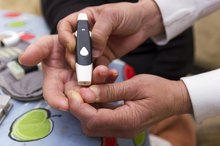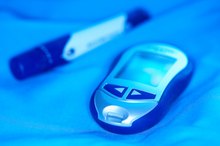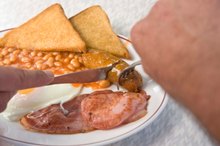Low Blood Sugar in Non-Diabetics
Blood sugar levels that drop too low can be just as dangerous as high blood sugar levels. This is especially a concern for diabetics, but nondiabetics can develop symptoms and health problems as well. To avoid complications it is important to be familiar with the warning signs of low blood sugar and what the common triggers are. If caught early, raising blood sugar levels with food can help avoid a life-threatening situation.
Identification
Low blood sugar, or hypoglycemia, is diagnosed when blood sugar or blood glucose levels drop below normal 23. Glucose is the primary source of fuel for the body and without enough of it, symptoms and health problems can occur. After a meal the food is broken down into glucose and either used immediately for energy or it is stored for use later on. According to the National Diabetes Information Clearinghouse, when blood glucose levels drop too low, the pancreas signals the liver to release the stored glucose into the bloodstream, until levels return to normal 1. If not enough glucose is available, symptoms can occur. For those without diabetes, normal fasting blood glucose levels should be between 70 to 99 mg/dL and between 70 to 140 mg/dL after eating a meal.
Symptoms
Does the Body Burn Fat When You Are Hungry?
Learn More
Without enough glucose the body will not be able to function normally. Early warning signs of low blood sugar include:
- hunger
- fatigue
- sweating
- headaches
- shakiness
- dizziness
- weakness
- confusion
- difficulty coordinating movement
- anxiety
- problems with vision
- upset stomach
- trouble speaking
- Medline Plus states 2
If left untreated, hypoglycemia can cause
In severe cases it can be fatal.
Causes
In those without diabetes, low blood sugar levels are usually caused by skipping meals or heavy alcohol consumption. However, certain medications can cause blood sugar levels to drop as can diseases that affect the adrenal or pituitary glands, which control hormone secretions, the Mayo Clinic reports. While rare, a tumor in the pancreas may cause too much insulin to be released, which can lower blood glucose to dangerous levels. Patients who have had gastric bypass surgery may develop a condition called reactive hypoglycemia in which the body releases too much insulin after meals 23. Diseases that affect the liver and kidneys can also interfere with the body's ability to regulate blood glucose. If hypoglycemia cannot be linked to skipping meals or alcohol consumption, a physician can run tests to determine the underlying cause 23.
- In those without diabetes, low blood sugar levels are usually caused by skipping meals or heavy alcohol consumption.
- While rare, a tumor in the pancreas may cause too much insulin to be released, which can lower blood glucose to dangerous levels.
Treatment
Low Blood Sugar in the Morning
Learn More
Eating carbohydrates is the first step in treatment for nondiabetic hypoglycemia 23. The American Diabetes Association suggests 1/2 cup of juice or regular soda, 2 tablespoons of raisins, 4 or 5 saltine crackers, or glucose tablets can be used 4. Then wait about 10 to 15 minutes to see if symptoms improve. If not, eat more carbohydrates and wait again. If symptoms persist consult with a medical professional. If a victim is unconscious, glycogen will need to be given through an IV. If there is an underlying disease causing the symptoms, then medications may be prescribed to help control hormone levels.
- Eating carbohydrates is the first step in treatment for nondiabetic hypoglycemia 2.
- If not, eat more carbohydrates and wait again.
Prevention
The best bet is to take steps to prevent low blood sugar. Drugs.com recommends eating five to six small meals a day to keep blood sugar levels steady with three to four servings of carbohydrates at meals and one to two servings for snacks. Avoid high sugar foods and watch caffeine intake, as both can make hypoglycemia worse 23. Drink alcohol in moderation, which means no more than one drink for women and two drinks for men each day, and make sure to consume carbohydrates if drinking.
- The best bet is to take steps to prevent low blood sugar.
- Drink alcohol in moderation, which means no more than one drink for women and two drinks for men each day, and make sure to consume carbohydrates if drinking.
Related Articles
References
- Medline Plus: Hypoglycemia
- MayoClinic.com Hypoglycemia
- Service FJ, Cryer PE, Vella A. Hypoglycemia in adults: Clinical manifestations, definition, and causes. UpToDate. Updated March 14, 2017.
- American Diabetes Association. 6. Glycemic Targets: Standards of Medical Care in Diabetes-2020. Diabetes Care. 2020;43(Suppl 1):S66-S76. doi:10.2337/dc20-S006
- Kishnani PS, Austin SL, Abdenur JE, et al. Diagnosis and management of glycogen storage disease type I: a practice guideline of the American College of Medical Genetics and Genomics. Genet Med. 2014;16(11):e1. doi:10.1038/gim.2014.128
- Desimone ME, Weinstock RS. Non-Diabetic hypoglycemia. In: Feingold KR, Anawalt B, Boyce A, et al., editors. Endotext. Updated September 23, 2017.
- Kalra S, Mukherjee JJ, Venkataraman S, et al. Hypoglycemia: The neglected complication. Indian J Endocrinol Metab. 2013;17(5):819-34. doi:10.4103/2230-8210.117219
- Martín-Timón I, del Cañizo-Gómez FJ. Mechanisms of hypoglycemia Unawareness and implications in diabetic patients. World Journal of Diabetes. 2015;6(7):912-926. doi:10.4239/wjd.v6.i7.912.
- Mayo Clinic. Hypoglycemia. Mayo Clinic Staff. Updated February 16, 2018.
- Service FJ, Cryer PE, Vella A. Hypoglycemia in adults: Clinical manifestations, definition, and causes. Updated March 14, 2017.
- Hormone Health Network. Nondiabetic Hypoglycemia. Endocrine Society. Updated October 2017.
Writer Bio
I hold a Master's degree in exercise physiology/health promotion. I am a certified fitness specialist through the American College of Spots Medicine and an IYT certified yoga teacher. I have over 25 years experience teaching classes to both general public and those with chronic illness. The above allows me to write directly to the reader based on personal experiences.









